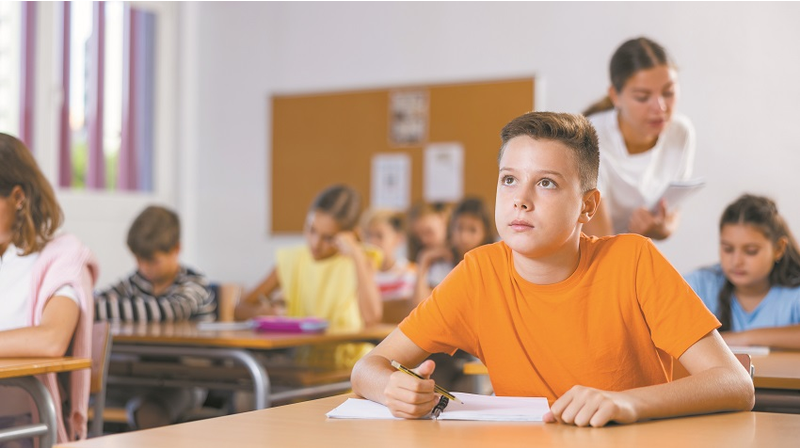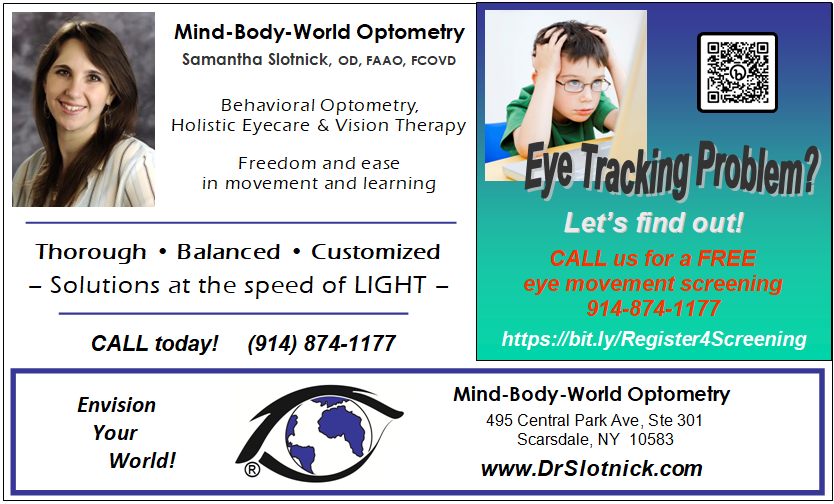Published: Sep 29, 2023 09:31AM ● By Dr. Samantha Slotnick
Natural Awakenings, Westchester, Putnam, Dutchess NY
There are many factors that mark why one smart, curious child excels in the classroom while another seems to be “smart in everything but school”. Children are naturally curious—they are often driven to explore their world, ready to learn more about anything which grabs their attention. But in the classroom, the primary mode of presentation is visual.
For success in school, a child needs to develop efficient use of several key visual skills (see below, “Key Visual Skills for Success in School” for a full list). A school screening will only detect whether a child can see clearly at long distance. But let’s consider the classroom experience.

Considering Focus and Distances in the Classroom
Children typically attend to a lesson at the front of the room and record notes (or copy material) at their desk. Whether this is done in writing or on a computer, children must adjust their focus to see clearly at long distance, near-point, and locations in-between. They also need to align their eyes as a team so that they keep single vision. Orienting skills are critical, as children learn how to put details into context. They need to perceive information over a large area, using peripheral vision. They need to follow moving objects to make sense of demonstrations. They need to maintain visual spatial memory, grabbing information from a distance, looking away to copy information at near, and then returning to the same place they had left off for the next “bite” of visual information.
Eye Movement, Steady Control and Smooth Transitioning
Eye tracking skills are a critical, often under-assessed component of a comprehensive pediatric eye exam. The three aspects of eye movement control are the ability to hold steady fixation, to shift visual fixation over a stable environment and to follow objects as they move across a person’s visual field. These abilities are not screened at all during well-visits with the pediatrician.
Most children are capable of clear and single binocular vision, sufficient for reading the eye chart at a distance of 20 feet on a screening. But for children to perform well at school, they also need to develop the eye movement control for supporting good comprehension when reading. This entails holding the eyes steady for long enough to gather information, and moving in planned, regular jumps across a line of text for reading. Inaccurate line-returns can lead to confusion, distraction, and loss of meaning. To manage this, some children find themselves reading aloud, using a finger to keep place, and even asking to be read to. A recent study in the South African Journal of Childhood Education (Raimundo da Silva Soares Jr, Candida Barreto, João R. Sato, 2023)[1] identified the critical role efficient, coordinated eye movements play in solving puzzles and mathematical problems as well.
Performance Affects Confidence
Successful performance in school is fundamental in a child’s sense of well-being. It’s so important that children learn to feel capable, confident and clever in their own particular ways. Without this, one’s self-esteem can falter. Frustration can lead to withdrawal. Also, expending excess effort to perform well can lead to many physical symptoms, including headaches and eyestrain. Physical discomfort and visual loss of place can become distracting, leading to interference with concentration and memory.
Recent research helped connect the dots between eye movement skills and quality of life (published in Archives of Rehabilitation Research and Clinical Translation, Nicholas P. Murray, Melissa Hunfalvay, Claire-Marie Roberts and more, 2021)[2]: Eligible participants were screened using the “RightEye” eye movement tracking system, and 92 (about 15 percent) were identified to have poor eye movement skills. These participants were divided into an intervention group and a control group; they also completed a questionnaire called the Neurobehavioral Symptom Inventory (NSI)[3], before and after the study.
Improvement with Practice
The NSI ranks a variety of symptoms of sensory and functional discomfort, including headaches, nausea, balance, visual variability, light sensitivity, sound sensitivity, concentration, memory, cognitive function and psycho-emotional symptoms. The control group simply took the pre- and post-eye movement tests one week apart. The intervention group also spent five minutes each day on eye movement exercises for five days. Their accuracy in eye movement control improved, and they also demonstrated significant NSI improvement. Thus, a brief period spent improving eye movement control directly resulted in a greater sense of comfort and balance for those that received treatment.
Careful Assessment is Vital
For children, thorough visual evaluation should include an assessment of all of these key visual skills. A behavioral or developmental optometrist can identify whether one’s eye movement skills are interfering with a child’s potential for success in the classroom. Treatment may include lenses and/or optometric vision therapy to develop sufficient eye movement control skills. A child that is frustrated, resists going to school, avoids reading, and learns to say “I can’t” before trying, deserves a functional visual evaluation. Vision therapy may help transform this struggling child into the happy, confident, self-directed youth who’s ready for discovery and independent exploration.
- Focus accurately (accommodation), to obtain and sustain clear vision at different distances
- Employ several eye-tracking (oculomotor) skills in concert: Fixation, saccades, and smooth pursuit
- Hold steady fixation, to gather information
- Make small, controlled eye jumps (saccades) for navigating through text and diagrams
- Track and follow moving targets (smooth pursuits)
- Maintain eye-teaming (binocularity) to adjust for single vision at different viewing distances
- Use peripheral visual field awareness to stay oriented when shifting vision
- Exercise visual spatial memory to support re-orienting between areas
Dr. Samantha Slotnick is a behavioral optometrist. Her practice, Mind-Body-World Optometry, at 495 Central Park Ave., Ste. 301, in Scarsdale, NY, is now providing free eye movement screenings with the RightEye eye-tracking system. Click HERE to register for a FREE eye movement screening. For more information, to register for her event or to make an appointment, call 914.874.1177 or visit DrSlotnick.com.
[1] Da Silva Soares Jr, R., Barreto,C. & Sato, J.R., 2023,‘Perspectives in eye-tracking technology for applications in education’, South African Journal of Childhood Education 13(1), a1204. https://doi.org/10.4102/sajce.v13i1.1204
[2] Murray NP, Hunfalvay M, Roberts CM, Tyagi A, Whittaker J, Noel C. Oculomotor training for poor saccades improves functional vision scores and neurobehavioral symptoms. Archives of Rehabilitation Research and Clinical Translation. 2021 Jun 1;3(2):100126.
https://www.sciencedirect.com/science/article/pii/S2590109521000306
[3] Cicerone,KD: J Head Tr Rehabil 1995;10(3):1-17. https://www.commondataelements.ninds.nih.gov/report-viewer/23032/Neurobehavioral%20Symptom%20Inventory%20(NSI)



Leave a Reply